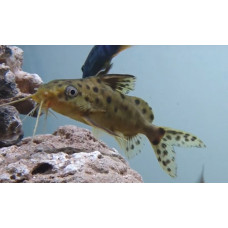Latin name
Corydoras punctatus
Other name
Corydoras punctatus
Identification
This species is rare. It is difficult to determine the sex of the fish until it is an adult. Facultative air-breathing.
Features of fish fins
Sexual dimorphism is well expressed, the pectoral fins of the male are noticeably longer and thicker due to the presence of a number of spikelets.
Fish colouring
Populations inhabiting darker substrates have more and larger patches.
Distribution
South America: Suriname River Basin in Suriname and the Iracoubo River Basin in French Guiana. Indo-Pacific region.
Habitat
Freshwater, bottom-dwelling tropical species. pH range: 6.0 - 8.0; dH range: 2 - 25; Depth range: 0 - 2 m.
Size
Maximum length: 6.6 cm.
Behavior
Prefers small, moderately sunny, shallow pools with sandy or sandy-silt bottoms. It is also found on the edges of stagnant areas of flooded forests (dams, lakes).
Food and feeding habits
The diet of these fish consists of benthic invertebrates.
Reproduction
The female holds 2-4 eggs between her pelvic fins where the male fertilizes them for about 30 seconds. Only then does the female swim to a suitable location where she lays very sticky eggs. The pair repeats this process until about 100 eggs are fertilized and attached.
Fishing
These fish are of no interest to the fishing industry.
Relationship with a person
Spotted catfish are widely used in aquariums.
| Classification | |
| Phylum | Chordata |
| Class | Actinopterygii |
| Squad | Siluriformes |
| Family | Callichthyidae |
| Genus | Corydoras |
| Species | C. punctatus |
| Features | |
| Conservation status | Least Concern |
| Habitat | Pelagic |
| Life span, years | No information |
| Maximum body weight, kg | No information |
| Maximum length, cm | 6,6 |
| Sailing speed, m/s | No information |
| Threat to people | Edible |
| Way of eating | Bentophage |
Spotted catfish
Tags: spotted catfish


